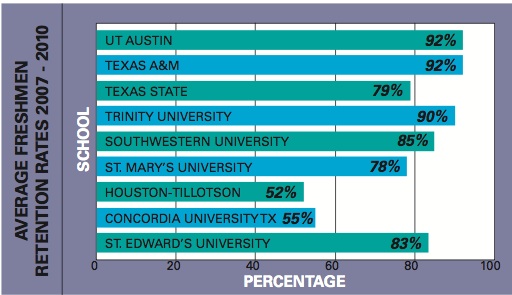Administrators could take steps to maintain and engage students

A graph shows the retention rates of different universities in Texas.
With student retention at St. Edward’s University declining steadily, school administrators are seeking ways to keep students coming back year after year. As students, we can provide some insight into why some students choose to leave St. Edward’s and offer suggestions about how the administration can engage students.
About three quarters of freshmen who entered St. Edward’s in Fall 2010 returned for the fall 2011 semester. That means almost one quarter of these freshmen did not return for their sophomore year. Retention is an indication of student satisfaction at a university.
There are many possible explanations for decreasing retention rates. School administrators cite financial concerns and a desire to major in a subject not offered at St. Edward’s, but other, less obvious reasons exist. And some have possible solutions.
One less obvious reason students might leave St. Edward’s is not feeling welcome on campus. While there are countless student organizations and Residence Life activities meant to get students involved on campus, some students inevitably fall through the cracks.
Furthermore, campus lacks a central “hangout” for students, key for fostering a welcoming atmosphere. Ragsdale and Meadows coffee shop are no replacement for a real student center. Ragsdale’s central location would make it the perfect place for a social center. School administrators would need to take action to make Ragsdale more appealing, such as replacing the bar that used to be in Fondren Hall, like Middlebury College’s The Bunker, an establishment that only serves alcohol on Fridays.
Another reason students might leave St. Edward’s is a lack of communication with students. Recent changes on campus have no doubt been jarring to some. The seemingly sudden announcement that there would not be a full-service library until Fall 2013 might have driven some students to leave.
Trivial changes like this week’s sidewalk closure near the parking garage could even make some students feel out of the loop. Small changes happen on campus often, and some students do not like being in an environment that is in flux.
The location of St. Edward’s in Austin is a draw to study here, but St. Edward’s often seems more concerned with its international connections than with its community. Engaging students at home is also important.
Oberlin College maintains a Community Service Work-Study Program in which students who qualify for Federal Work-Study engage in programs off campus such as tutoring and environmental restoration. St. Edward’s prides itself in service learning, so this seems natural.
St. Edward’s administration could do several things to help retain students. The most important is better communication. Implementing programs to retain students is important, but these programs will not help unless students know they exist.
The main St. Edward’s social media accounts are run by the Marketing Department. They read like an advertisement for St. Edward’s, not a source of information for students. The university could utilize social media to inform students of changes on campus.
Retention is important, but so is fostering a community for students who already intended to stay. Improving communication, integrating work-study with service learning and establishing a central gathering place on campus could both retain and engage.







![According to a 1993 archive from Congressional Quarterly Almanac, “[Judge] Ginsburg was known as a restrained and fair-minded judge who did her homework and then some.” She was “considered moderate to conservative on criminal issues and business law,” relatively progressive “on issues such as free speech, religious freedom and separation of church and states,” and more liberal on “civil rights and access to the courts.”](https://www.hilltopviewsonline.com/wp-content/uploads/2020/10/VP-4RBG_CC-by-WFULawSchool-475x317.jpg)
